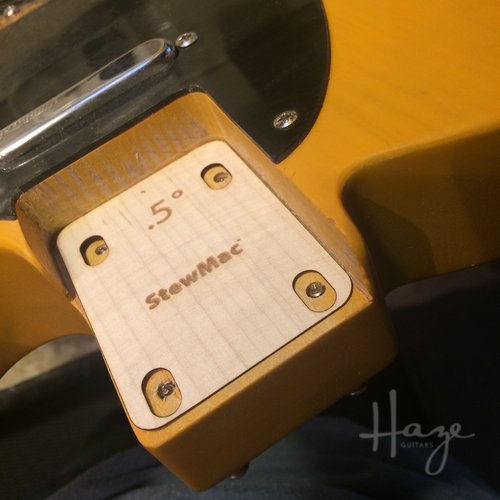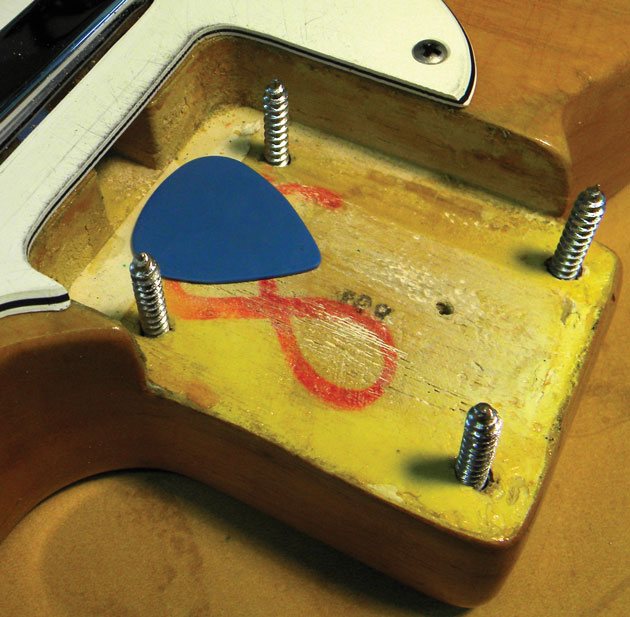I lowered the action on a bad playing, gift acoustic. I thought this might be informative for some of you. This was my first time doing this. I hardly ever play acoustic. I haven’t owned a full sized acoustic in 15 years. lol. 




Cool video! I have an Ovation acoustic and when I went to lower the action it had those plastic shims under the saddle. All I needed to do was take them all out and I was set.
Yep! a lot of guitars have the shims I think. I wanted to add that I left out the last step to correctly do this. It’s good to plane the bottom of that saddle strip perfectly flat and smooth with a flat file or fine sandpaper or something. I will do that when I re-string. I threw it back in just to make sure adjustment is good.

Does your cheap guitar still have high action with your bridge all the way down? Shim them babies with aluminum foil. 
Luthier Pooh 

I usually use business cards for that. :lol: Eric Johnson, I believe, advocates nylon picks, to try to isolate the neck vibrations from the body, but he’s a whole other level of tone chasing than I am.
I usually use a wood block and some 180-grit sandpaper to resurface the pocket to a better angle. I also sand the finish off of the neck heel to get wood-to-wood contact.
I do this on every bolt-on I buy. Some of them were in terrible shape from the factory. Surprisingly, the price of the guitar doesn’t seem to correlate with the quality of the neck joint. One of the cleanest and flattest neck joints I found was on a $80 Epiphone Special. One of the worst was in a Fender strat from the early '90s. All kinds of crap in there (business cards, picks). The pocket was all gouged up and not even remotely flat. Nice guitar, though, otherwise.
I hear a lot of guys say they use business cards. Seems like a good idea. I don’t think isolating the neck from the body is a good idea though. I more so agree with @induction on wood-to-wood contact being better for sustain and resonance. I don’t think it’s a good idea to have bare wood anywhere on a guitar though. Maybe it doesn’t matter if it’s not exposed from the closed neck pocket. Speaking of sandpaper, I actually shimmed one of my Kramers with a piece of 180 grit. lmao. I had to sand the pocket flush on this one, it had overspray runs in the joint. 
Ok, so I played with pretty high action for a while. I decided to come down to a more “stock” guitar setup. I found that my black Kramer had a high fret.
I fixed the buzzing high fret with sandpaper. Sometimes frets can lift out of the fingerboard a little. So make sure you can’t tap the fret down with a rubber mallet before doing any sanding/filing. Also make sure the fret re-seats itself if you do have to tap it back in the board. Sometimes a lifted fret requires a dab of superglue to re-seat.
-Amateur Luthier Pooh

Luthier Pooh is back at it again. This time we fix those vintage saddle screws that keep stabbing your hand. 
I would strongly advise against anything but a full pocket neck shim because the downward force over a partial shim will start to warp the end of the neck. This can lead to strings fretting out and a neck in need of refinishing and refretting. This is why Fender stopped doing this. A partial shim also kills sustain. Hence the age old “Gibsons have more sustain than Fenders.”
If you don’t feel like making an angled shim. StewMac sells them.
I agree with what you’re saying for the most part. But this bass guitar neck in your link is an extreme example of shimming right against the body in the pocket. I made my shims so the lip is actually underneath the rear screws.
At the time, I wanted a cheap, quick fix for those guitar setups. I just chose to shoot videos doing it. Thinking about it now, those weren’t the best videos to make.
The problem with stew macs is you don’t really know which degree you need. And isn’t a 3 pack 50 bucks? That’s highway robbery man.
What I’m going to do eventually is any of the guitars I’m keeping, out of the ones I shimmed; I’m going to go back and stewmac shim them.
I’m all about paper shims. Video below demonstrates the concept using masking tape, but I usually use 3x5 cards cut to the length of the neck pocket (minus a buffer around the perimiter to avoid binding against the sides of the pocket) and equal fractions of the neck pocket length, (number of subdivisions depending on how much slope I need). The end result is like a little paper flight of stairs, with one layer of paper for each “step”; two equal steps (a half neckpocket length on top of a whole neckpocket length) equals the smallest slope. Three equal steps is the next steepest. Etc. etc. If you ever needed to, you could use thinner paper instead of typical card stock.
Yeah man, Similar to the tape method you shared, I’ve had several repair guys tell me they use aluminum foil. Folded in layers to emulate a wedge. I could have spent more time on the foil job I did and made a full pocket shaped shim. You can’t tell me that a stepped up aluminum foil wedge is going to warp a neck. The surface pressure mashes the wedged foil to a even more perfectly wedged shim when you bolt the neck on.
Unfortunately they have this forum setup where you can’t delete a post after it’s been up a month or so now. So I can’t remove the old shim videos from here. I’ll do a Stewmac shim video, then link the old videos to the Stewmac… I guess. To hell with neck shimming. Agitating subject. 
I’d really want to see that same straightedge test done on the fretboard side of the neck before I’d come to that same conclusion. To me, the fat more plausible conclusion would be that over time the shim slightly compressed the wood at the base of the neck heel, rather than the whole neck was bent at the very tip of the heel. It’s pretty easy to compress wood, even a fairly hard wood like maple, over time. It’s EXTREMELY hard to bend it.
Also, I’ve heard as many people argue for isolating the neck from the body to improve sustain, as I have heard argue that a shim kills sustain. Some of them are just crazy enough to maybe be taken seriously - Eric Johnson, for example, if I remember right, is an advocate of nylon shims to isolate neck and body vibrations anywhere except for through the strings, and he takes tone more seriously than anyone else I can think of.
I’m with you on the neck shim warp theories Drew. I think if you shim up to the bottom 2 neck bolts… There is no way for the neck to warp. The warping comes from the narrow shims that are placed right on the bottom of the pocket leaving a huge gap between the thin shim and the bottom neck screws.

I have Stew Mac shims now though… I will be re-shimming and updating my shim videos as soon as I get around to rotating those guitars out of storage again. I use 1 or 2 guitars at a time… keep the rest in storage. I rotate guitars on the re-strings. That keeps most of them safe from theft… and it makes maintenance easier. I don’t have 10 guitars sitting around with half carroded strings that way.

I’d be curious if you hear any tonal/sustain differences, Hanky. I’ve personally never noticed anything on an unshimmed vs shimmed neck (aside from the improvement in playability, if a shim was necessary) but it’s been a long time since I’ve taken a guitar with no shim and shimmed it, so who knows.
That would be a good video idea right there Drew… The shim video, with before and after tonality.
I think a lot of that stuff effects the guitar tone/sustain a little… a lot of this stuff is so little you can’t tell unless you are playing the guitar I think. I started doing a secret neck pocket trick to my guitars to improve the sustain and string vibration transfer through the body. Is it a huge difference? No. Do I feel the difference playing it. Yeah. You notice these things the most playing it unplugged and listening to it acoustically. My best sounding guitar is loud unplugged… and the guitar body vibrates my ribs when I’m playing it.









